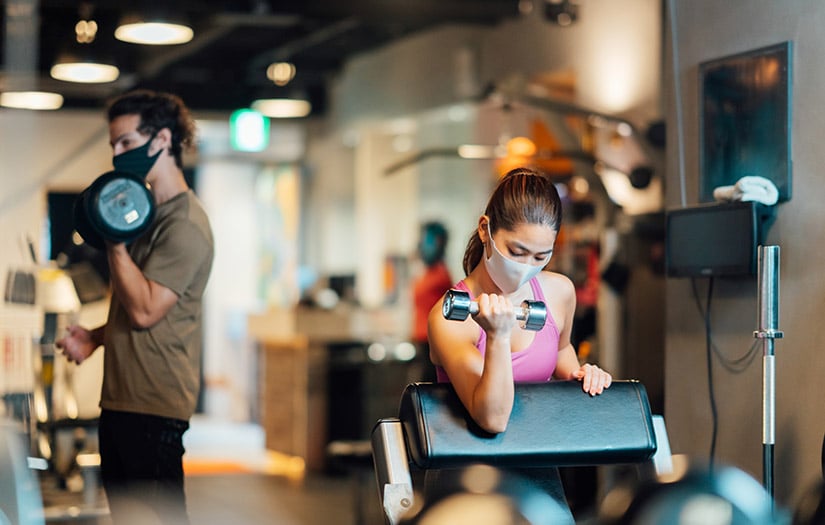The fitness professional may play a vital role in helping post-COVID-19 clients return to physical activity. COVID-19 can have a significant impact on an individual’s health resulting in possible long-term complications.
Recent research documented that 80% of individuals hospitalized with COVID-19 experienced at least one lingering symptom six months after recovering (Huang et al., 2021; Lopez-Leon et al., 2021).
Researchers have identified more than 50 long-term effects of COVID-19 among these individuals (Lopez-Leon et al., 2021). The five most common long-term complications include fatigue (58%), headache (44%), attention disorder (e.g., COVID-19 fog) (27%), hair loss (25%), and shortness of breath (24%) (Lopez-Leon et al., 2021).
For the post-COVID-19 client, there are several emerging questions regarding exercise after recovering, how professionals can guide them, and the influence of vaccination on their ability to exercise.
This blog will provide some insight into common questions. For more on this topic, be sure to check out NASM's Covid Management Course.
Can you exercise after having COVID-19?
The short answer is yes! But it needs to be implemented with caution. The post-COVID-19 client may be deconditioned due to physical inactivity and have long-term complications to effective body systems such as the cardiac, pulmonary, and musculoskeletal. Experts have developed four specific recommendations for post-COVID-19 exercise (Metzl et al., 2020):
- The client should not resume exercise if they have a persistent fever, shortness of breath (dyspnea) at rest, cough, chest pain, or heart palpitations.
- Any client with an underlying cardiovascular or pulmonary condition should consult a qualified healthcare provider before resuming exercise, even if asymptomatic.
- Fitness professionals should consult with qualified healthcare professionals if their post-COVID-19 client develops chest pain, fever, palpitations, or dyspnea on the resumption of exercise.
- If a client is otherwise healthy and has been asymptomatic for seven days may begin resuming physical activity at 50% of average intensity and volume.
The fitness professional should consider that these exercise recommendations may not apply to each client due to their individual needs, functional abilities, and goals. Also, other exercise guidelines may exist, given the amount of research published on this topic each month.
How can I safely guide my client when returning to physical activity after have COVID-19?
The research on physical activity for post-COVID-19 individuals is still emerging, with no consensus on the optimal exercise program for these individuals. Despite no agreement, there is preliminary research that provides some insight into this topic. Experts have suggested guidelines base upon a 4-phase exercise program (Salman et al., 2021).
The Rating of Perceived Exertion scale (RPE) guides a client's perceived intensity during exercise and helps progress through the different phases. Phase 1 is considered a preparatory exercise phase, while phases 2 to 5 are a progression of physical activity measured by a higher RPE intensity range. Each phase is recommended to be a minimum of 7 days to prevent a sudden increase in training load and allow the client to adapt. Clients are advised to stay at the phase they feel comfortable with as long as necessary. Clients should experience an average recovery within 1 hour after exercise and the next day.
Clients should not experience any symptoms such as difficulty breathing, abnormal pulse rate, excessive fatigue, mood, or mental health issues (Salman et al., 2021). Figure 1 details the 4-phase exercise program. As mentioned in the prior section, this program may be one of many published post-COVID-19 exercise programs.
The fitness professional should attempt to match the exercise program to each client's unique needs. Communication with the client's healthcare team may help to provide insight and ensure client safety during exercise.
.jpg?width=962&name=Working%20Out%20After%20COVID%20-%20Figure%201%20(2).jpg)
Figure 1. Phased Return to Physical Activity (Adapted from Salman et al, 2021)
Does exercising after vaccination create any safety concerns?
The different COVID-19 vaccines may create local and systemic side effects such as fatigue, headache, fever, localized pain, and tenderness at the vaccination site, which can last several days (Ghram et al., 2021). Currently, there are no published guidelines on exercise after receiving any of the approved vaccines.
Clients may want to refrain from exercise if they are feeling symptoms and consult with their healthcare provider for exercise advice if needed. Best practices for fitness professionals include ensuring the client is asymptomatic and/or cleared by their healthcare provider before exercise participation.
Due to the many unknowns, client safety should be considered first until more evidence-based guidelines are produced on this topic. Fitness professionals should also consider those individual responses to vaccination may occur among different clients. For example, post-COVID-19 individuals getting vaccinated may have their unique answer due to already having the disease. Due to the lack of research and unknowns, fitness professionals should focus on client safety as they return to physical activity.
Does exercising after the vaccines help boost the immune response?
The short answer is maybe! Researchers have suggested that exercise after vaccination may produce a positive immune response among individuals (Valenzuela et al., 2021). This hypothesis is based upon prior vaccination research (e.g., influenza) that suggests exercise might induce a more robust antibody response.
Recent large-scale studies from the United States and Brazil support this theory. Researchers found that active individuals (≥ 150 min a week of moderate-intensity, or 75 min a week of vigorous-intensity physical activity) had a lower risk of hospitalization, admission to the intensive care unit, and death due to COVID-19 when compared to sedentary individuals suggesting a positive immune response from exercise (de Souza et al., 2021; Sallis et al., 2021).
Currently, there is no research regarding the effects of combined training and COVID-19 vaccination on immunity (Valenzuela et al., 2021). Future research should examine the benefits of combining both interventions.
Conclusion
This discussion covers some emerging questions regarding post-COVID-19 exercise and the influence of vaccination. Fitness professionals should consider that the research on COVID-19 is still emerging, and the virus is novel. The suggested guidelines discussed in this blog are not all-inclusive as other publications and recommendations may exist.
The fitness professional should ensure a safe environment by working closely with the client and their healthcare team before implementing an exercise program. The fitness professional should also stay current with this topic as new research is being published monthly. The new NASM COVID-19 Fitness Management course also provides more comprehensive coverage of this topic.
References:
- de Souza, F. R., Motta-Santos, D., dos Santos Soares, D., de Lima, J. B., Cardozo, G. G., Guimarães, L. S. P., Negrão, C. E., & dos Santos, M. R. (2021). Association of physical activity levels and the prevalence of COVID-19-associated hospitalization. J Sci Med Sport. https://doi.org/10.1016/j.jsams.2021.05.011
- Ghram, A., Moalla, W., & Lavie, C. J. (2021). Vaccine and physical activity in the era of COVID-19 pandemic. Prog Cardiovasc Dis, S0033-0620(0021)00029-00023. https://doi.org/10.1016/j.pcad.2021.03.001
- Lopez-Leon, S., Wegman-Ostrosky, T., Perelman, C., Sepulveda, R., Rebolledo, P. A., Cuapio, A., & Villapol, S. (2021, Jan 30). More than 50 Long-term effects of COVID-19: a systematic review and meta-analysis. medRxiv. https://doi.org/10.1101/2021.01.27.21250617
- Metzl, J. D., McElheny, K., Robinson, J. N., Scott, D. A., Sutton, K. M., & Toresdahl, B. G. (2020, Aug 10). Considerations for Return to Exercise Following Mild-to-Moderate COVID-19 in the Recreational Athlete. Hss j, 16(Suppl 1), 1-6. https://doi.org/10.1007/s11420-020-09777-1
- Sallis, R., Young, D. R., Tartof, S. Y., Sallis, J. F., Sall, J., Li, Q., Smith, G. N., & Cohen, D. A. (2021). Physical inactivity is associated with a higher risk for severe COVID-19 outcomes: a study in 48 440 adult patients. British Journal of Sports Medicine, bjsports-2021-104080. https://doi.org/10.1136/bjsports-2021-104080
- Salman, D., Vishnubala, D., Le Feuvre, P., Beaney, T., Korgaonkar, J., Majeed, A., & McGregor, A. H. (2021). Returning to physical activity after covid-19. BMJ, 372, m4721. https://doi.org/10.1136/bmj.m4721
- Valenzuela, P. L., Simpson, R. J., Castillo-García, A., & Lucia, A. (2021). Physical activity: A coadjuvant treatment to COVID-19 vaccination? Brain, behavior, and immunity, 94, 1-3. https://doi.org/10.1016/j.bbi.2021.03.003

















